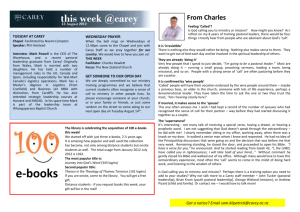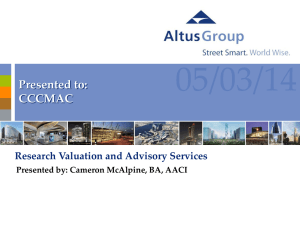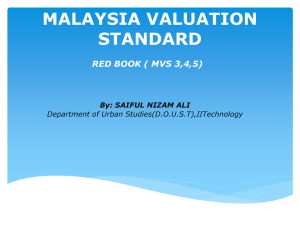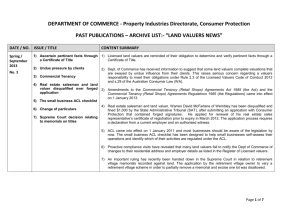Reflections on appraisal and valuation of born digital collections
advertisement
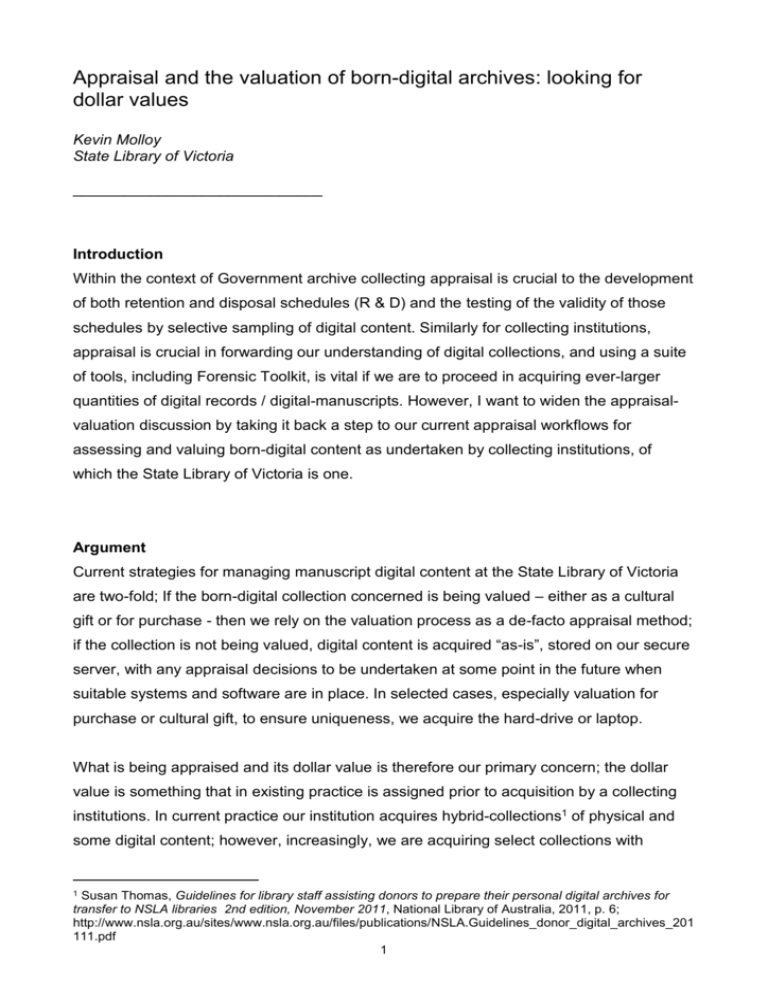
Appraisal and the valuation of born-digital archives: looking for dollar values Kevin Molloy State Library of Victoria _____________________________ Introduction Within the context of Government archive collecting appraisal is crucial to the development of both retention and disposal schedules (R & D) and the testing of the validity of those schedules by selective sampling of digital content. Similarly for collecting institutions, appraisal is crucial in forwarding our understanding of digital collections, and using a suite of tools, including Forensic Toolkit, is vital if we are to proceed in acquiring ever-larger quantities of digital records / digital-manuscripts. However, I want to widen the appraisalvaluation discussion by taking it back a step to our current appraisal workflows for assessing and valuing born-digital content as undertaken by collecting institutions, of which the State Library of Victoria is one. Argument Current strategies for managing manuscript digital content at the State Library of Victoria are two-fold; If the born-digital collection concerned is being valued – either as a cultural gift or for purchase - then we rely on the valuation process as a de-facto appraisal method; if the collection is not being valued, digital content is acquired “as-is”, stored on our secure server, with any appraisal decisions to be undertaken at some point in the future when suitable systems and software are in place. In selected cases, especially valuation for purchase or cultural gift, to ensure uniqueness, we acquire the hard-drive or laptop. What is being appraised and its dollar value is therefore our primary concern; the dollar value is something that in existing practice is assigned prior to acquisition by a collecting institutions. In current practice our institution acquires hybrid-collections1 of physical and some digital content; however, increasingly, we are acquiring select collections with 1 Susan Thomas, Guidelines for library staff assisting donors to prepare their personal digital archives for transfer to NSLA libraries 2nd edition, November 2011, National Library of Australia, 2011, p. 6; http://www.nsla.org.au/sites/www.nsla.org.au/files/publications/NSLA.Guidelines_donor_digital_archives_201 111.pdf 1 greater digital content than physical. In all cases the assessment, and the valuation of these collections is linked to a dollar value in “valuation for purchase” or valuation under the tax incentive Cultural Gifts Scheme. In looking for the overall intrinsic meaning, cultural importance, and, from our perspective, certainly dollar value, are we assessing data (and the Forensic Toolkit, with the proper vocabularies does appear to be able to undertake this with ease); or are we appraising and valuing manuscripts, something, as David Sutton has noted, requires us to ‘understand who made them, how they were made, the unique relationship between author and evolving text, [and]…the insights they give into the act of creation’.2 My feeling is that in the future it will be necessary to do both. The argument I am going to put forward is one that links the appraisal process to the valuation, as it is the high-end, high-profile writers, artists and other creatives (landscape gardeners for example), who are currently the greatest formulators of born-digital content that arrives in the Manuscripts Collection at my collecting institution; this, therefore, will be my focus, rather than looking at business or political records where vast volumes of digital material can be produced over time, or photographic digital content, which has its own specific issues. How content is appraised, by whom, and who assigns the dollar value, whether the institution or the valuers (if they have the necessary skills and software), is therefore an urgent problem and something I would like you to consider. In some senses I will be playing “devil’s advocate” here, and like the eighteenth century Irish philosopher Bishop Berkeley in his Querist, throwing out queries to the audience for consideration and perhaps discussion: What are the challenges, difficulties, or similarities between valuing physical content and digital content; What sort of new assessments – appraisal and valuations - are required; 2 David C Sutton, The destinies of literary manuscripts: past, present and future, Archives and Manuscripts Vol. 42, No. 3, p. 295. 2 What skill sets are needed by collecting institution staff, the current list of approved valuers, and auction houses, to quickly appraise sometimes thousands of digital files (word documents and other file types); How different is it assigning dollar values to digital content versus physical content How thorough should the appraisal process be before valuation? To date (and to my knowledge) no digital content has come on to the Australian “Rare Book”, or “Manuscript” market; auction houses have not as yet had to deal with this; will this change in the future?; does this have any implications for the assessment and valuation of born-digital content; and if so, what would be the challenges to auction houses if they started engaging in digital heritage content and using their own digital contractors to assess and determine value? At what point should the collecting institution intervene in the valuation process of born-digital content, and what are the legal implications for the valuation process if this is to be, increasingly, a requirement? Currently, heritage valuers in Australia have an open hand in appraising and valuing digital content, usually done by sampling and comparison with physical content. Is software, like the Forensic Toolkit, an aid or hindrance to the valuation process? Is it software that is valuing-adding, in terms of dollar value, to the valuation process? - not something that is currently done with physical records; And who should be using software like Forensic Toolkit? Should its use, or similar software, be a mandatory requirement for valuers and heritage institutions? Is Forensic Toolkit something that the ATO might require their valuers to be familiar with, and to have used before approved valuer status for manuscripts material is granted? Finally, what are the requirements for uniqueness in digital content, something that stands outside the functionality of software like Forensic Toolkit, but something that requires the direct intervention of the institutional manager to make the judgement 3 call that sets the appraisal and valuation in motion. How do you capture unique digital content, if that is your aim? In my most recent discussion with a major private collector of Australian manuscripts I broached the idea of private collectors’ actually purchasing digital content…a notion that brought him near to the abyss!; but it is something echoed in the observations of Sutton and Chassanoff.3 Obviously, digital content in some quarters is fundamentally quite removed from the notion of being a tangible cultural object invested with the aura and mystique of previous owners and collectors; and it is very unlikely that digital content is going to end up in publications like that of the BBCs Village Roadshow’s Catalogue of Collectibles. The NSLA requirements for dealing with born-digital content and working with the creators of records before transfer, Guidelines for library staff assisting donors to prepare their personal digital archives for transfer to NSLA libraries (2011), is a fine document, and aspirational in trying to possibly emulate ideas implicit in government R&D appraisal schedules for collecting institutions; with government archives the type of intervention asked for in this document is very much a given, and in some jurisdictions this type of preemptive intervention is commonplace. In practice however, for collecting institutions, such interventions are largely impossible, or require considerable goodwill, and an acknowledged commitment on the part of the institutions, many years out, that they will acquire the records at some point in the future. I recently had a case at the State Library of Victoria when I was approached by a writer of self-help and actualisation texts to whom the Library, in the early 1990s, had made a tentative commitment, describing this writers output as a collection that was well suited to their current collecting policies. However, the writer was not then ready to hand over her work. Twenty-five years later on approaching us to deposit, we realised this was not the sort of collection that had any intrinsic cultural of literary value or met with our current collection development policies; so, we declined the offer, much to the writer’s disgust, and a very angry follow-up letter. The window of opportunity was gone, as the institutional requirements had drastically changed. My feeling then and now, is to be wary of collection Alexandra Chassanoff, ‘Historians and the Use of Primary Source Materials in the Digital Age’, American Archivist, Vol. 76, No. 2 (Fall/Winter 2013), p. 463. 3 4 promises and long-term commitments to donors and vendors as values and policies often diverge considerably over time. There are currently a number of categories of born-digital manuscript records that are appraised by valuers and then assigned a dollar value: Typically the high-end writer, artist, cartoonist, composing on a laptop or camera and often producing many thousands of files either of the same image, variations, or new iterations of chapters, or sometimes new files for every versions of a corrected paragraph; Architectural files created on CAD (Computer Aided Design) software - files that are never final, as client files are often revisited over a number of years. On offer to an institution, in most cases, is a digital snapshot, as the hard drive is still operational and its content may be used for the life of the company. And of course email and other social media forms; email, for example, at once both cursory and dense, and more often than not containing data that is intrinsically different to a traditional letter, is now largely stored on external servers like G-mail or Cloud products, rather than on older software like the widely used Eudora Mail (formerly the preferred system of writer Peter Carey for example). Such content is generally not offered to collecting institutions as unique packages for appraisal or valuation; while a number of years ago email could be stored on a laptop or computer and appraised and valued along with all other digital content, such days are now gone, and writers are more wary of providing email access to their accounts on external servers when the topic is broached. Example Collections: Peter Carey Forensic Toolkit is increasingly being used by a number of institutions, especially in the United States, where institutions like Columbia University and the New York Public Library are readily adapting this software for their content assessment and descriptive needs; and as Emma has noted, this is now firmly on the agenda at the National Library of Australia. With this in mind I would like to look closely at recent valuations for largely born-digital content that have been undertaken at the State Library of Victoria, as a way of 5 contextualising current practice in both understanding, at a glance, the nature of the digital records, and then assigning a value for them. The collection that stands out most is that of Peter Carey. The State Library of Victoria has been acquiring collection Carey material since 1999 but it was with the purchase of Carey’s Laptop in 2001 with its multiple drafts of the Booker winner True History of the Kelly Gang, plus thousands of emails and other documents, that the Library embarked upon a new age of collecting literary works in purely digital form, and acquiring the complete laptop/hard-drive to ensure the records uniqueness and authenticity. The subject of a major recent journal article by Rowan Wilkin in the journal Cultural Studies Review, Carey’s Apple Mac Classic has achieved almost cult status, and, with Ned Kelly’s armour, is one of the most visited and referenced objects on display within the State Library of Victoria.4 Since 2001 the Library has built an impressive collection of Carey manuscripts, largely born-digital, documenting the writing and reception of all of his major novels. Further digital manuscripts were acquired in 2008 when multiple drafts of the novels My Life as a Fake, Theft, a Love Story, Wrong about Japan and His Illegal Self were acquired with the acquisition of a another laptop; in correspondence with the Library Peter Carey noted that there was far more material in digital form for the works My Life as a Fake and Wrong about Japan (2004), than existed in paper form. In 2012 the Library purchased Carey’s writings on his two novels Parrot and Olivier in America (2009), shortlisted for the American National Book Award, and Chemistry of Tears (2012) together with a large cache of other laptop writings. Carey’s methodology is to compose exclusively on his laptop and he is disciplined in maintaining a nominally rigorous file structure that reflects each new iteration of a chapter or sub-chapter, sometimes completed on a daily basis. These discrete files document in detail his multiple draftings and revisions. It should also be noted that Carey does not send out work to friends or other readers during the composition of a novel, unlike, for example, Alex Miller, thus there is very little in his collection that might be considered ‘reader reflections’ or critiques of ‘work in progress’ that appear on hard copy form. In effect, Carey drafts and re-drafts and only when he has 4 Rowan Wilken, ‘Peter Carey’s Laptop’, Cultural Studies Review, Vol. 20, No. 1, 2014, pp. 98-118. 6 substantially completed a work, or major component of a work, is its draft printed out and submitted to an editor or reader. Further, and adding to the primacy of the electronic work, Carey has noted that he does not keep physical diaries or journals during the composition of a work. Thus, there is nothing reflecting on or illuminating the creative process except the digital files themselves. Valuation of Carey’s material has been one where new ground has been broken but it has also been one where the valuers have been presented with a new range of challenges. Over the last decade there have been few precedents in Australia for valuing literary archives where the bulk of the material is in born-digital form. Our valuers worked with Carey, from a distance, endeavouring to understand his methodology, and creation process. Ease was further facilitated by the fact that Carey adopts a seemingly logical file structure, hashtagging and numbering each new iteration or variant of a paragraph or chapter so that some logical progression in his creative process is evident. Each new variant is built on a new copy of the old and all are meticulously numbered. Without this there would be potential for chaos, though on looking at his most recent collection of over 10,000 digital files it is not immediately apparent to the reader or valuer what you are actually seeing: As one of our valuers noted: For those writers who now work more or less exclusively with electronic files, I think that at the point these files are submitted for appraisal/valuation there is an obligation on the author to ensure there is transparency – that records are clearly identified and their particular status or significance as drafts is properly described. In hard copy, this is what Alex Miller does. In electronic form, Carey does not provide an equivalent clarity or certainty.5 And because of this apparent lack of clarity contact with the author/creator, limited though it was, was deemed essential for a sound understanding of the creation process. Parallels can of course be drawn with non-digital literary archives and the prolific output of one writer was noted to me as an example; ‘a huge mass of paper, barely explained or well organised therefore a poor correlation between the worth of the paper and the writer’s reputation becomes a case in point’. When no efforts are made to identify differences in 5 Pers. Com. Kevin Molloy, April 2015. 7 particular pieces of paper, or digital files, then the appraisal, valuation and value all suffer. Of course the creator must exercise some editorial or archival responsibility in making a collection available for appraisal and valuation, but in most cases this does not happen. If you are offered a collection by a noted writer or artist, as-is, the institution never quibbles!! Where could the Forensic Toolkit fit into this appraisal for valuation process? To further draw upon one of our valuer’s comments concerning Carey’s material: A problem with the electronic record is that while successive drafts may be identified as such, by definition the new draft takes in an author’s changes/revisions invisibly. Of course the changes are there but it would require a very close reading of each different stage for the quality and extent of authorial changes to be understood and their significance fully appreciated. You will understand that this makes for quite considerable difficulty for, say, a valuer to comprehend the status/significance of key drafts – and it makes the valuing process more onerous and more expensive than it should be.6 And true, no scholarly access has as yet been granted to Carey’s digital drafts so it is currently difficult to gauge the level of interest for specialised research with digital files; however, in discussion with a noted Australian literary editor and occasional Carey scholar, the thought of having to read and compare thousands of files, per novel, to understand the authorial editing process appeared to be something that presented considerable challenges in terms of time, commitment and understanding. Forensic tools can certainly sidestep this process and are obviously of value on a range of levels and to a range of users - archivists, students, professional researchers, and of course valuers. Conclusion You can take a discrete sheet of paper or file and place it in an auction and be relatively certain of where it fits in a writers output and what its value is; could you take a discrete digital file to an auction house and expect the same? Unlike physical records the value of digital content appears to lie in its relation to the cumulative data-stream of a particular creation; clearly and cumulatively, digital content has value over and above discrete digital files, and possibly constitutes a major difference with physical content. 6 Pers.com. Kevin Molloy, April 2015. 8 The general consensus amongst valuers I have spoken with is that currently they do not have the necessary skills or time to interrogate large quantities of digital files. Therefore, at some point, serious intervention will be required to both appraise, understand and value digital manuscripts. Forensic Toolkit is one obvious answer, but how it is used, by whom, and at what point, will ultimately determine its value. 9
